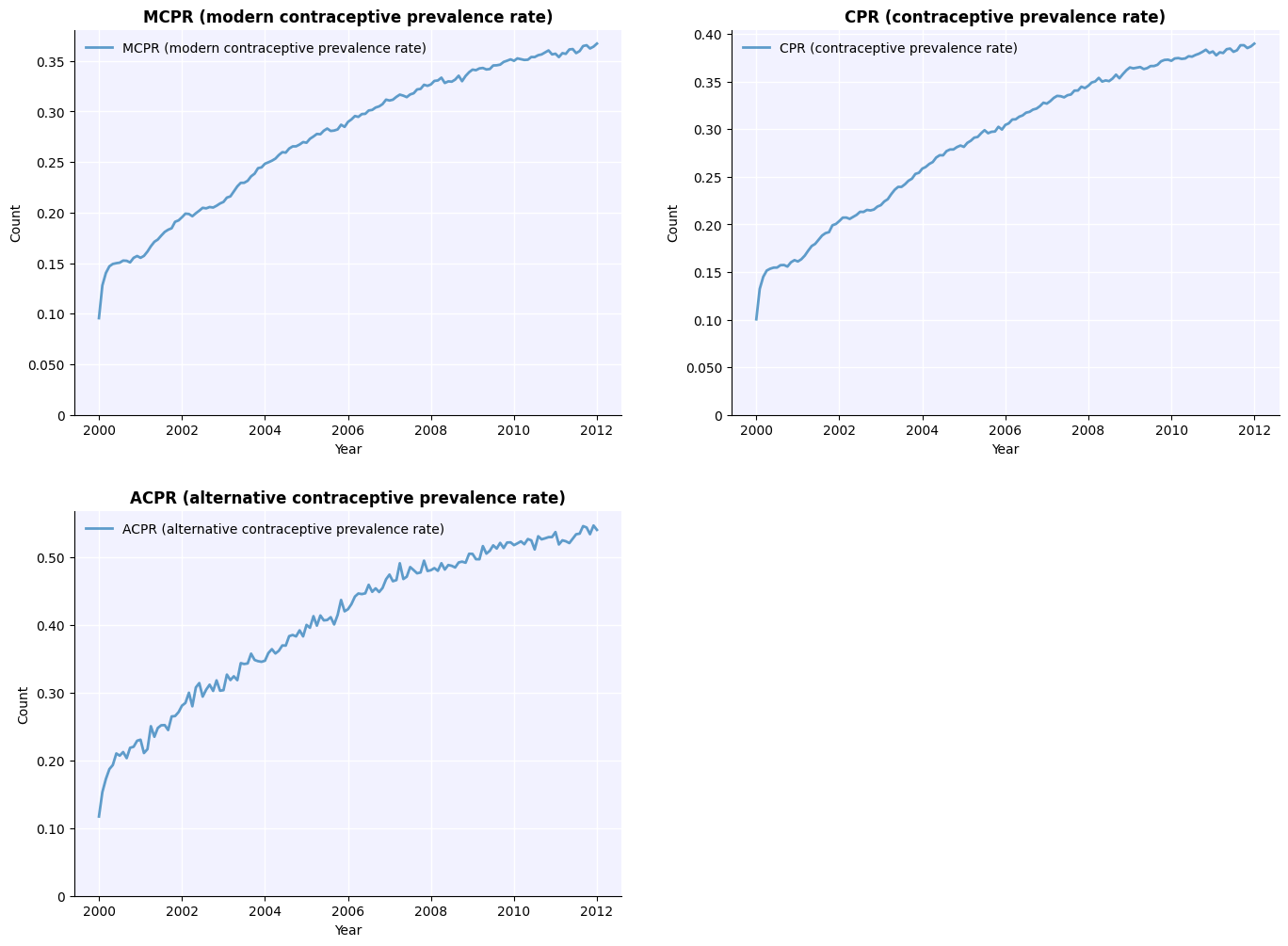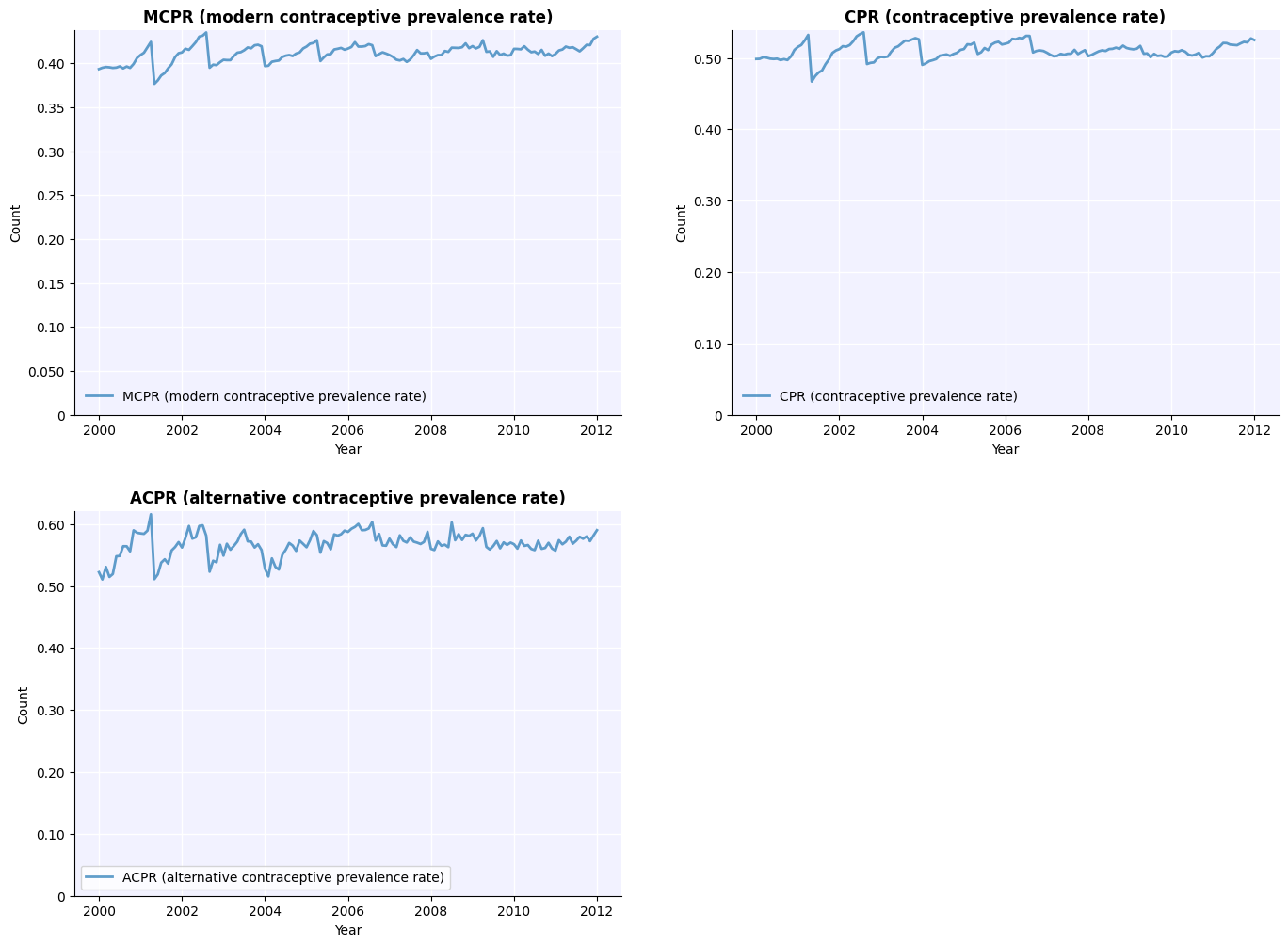An interactive version of this notebook is available on Google Colab or Binder.
Adding a new method#
At this point, you should be able to ru FPsim, create interventions, and set eligilble subpopulations for that inervention. Now, let’s see how to create a different type of intervention: introducing a new contraceptive method. First, import the model.
[1]:
import fpsim as fp
import sciris as sc
import starsim as ss
/home/docs/checkouts/readthedocs.org/user_builds/institute-for-disease-modeling-fpsim/envs/latest/lib/python3.11/site-packages/tqdm/auto.py:21: TqdmWarning: IProgress not found. Please update jupyter and ipywidgets. See https://ipywidgets.readthedocs.io/en/stable/user_install.html
from .autonotebook import tqdm as notebook_tqdm
We will start by making a copy of the default list of contraceptive methods used by FPsim. We need this so that we can add our new metod to the list.
[2]:
my_methods = fp.make_methods()
Define a new method#
To define and parameterize your new method, you need to enter attributes:
A simple name, which needs to be concise because it will be used inside the code.
Efficacy, defined as a percent.
Whether it is a modern method or not, defined as true or false.
Duration of use, or time on that method, which can me defined as a number of months, or a distribution. If you choose a distribution, you need to define the type of distribution (e.g. lognormal, loglogistic, …) as well as the parameters for that distribution. See tutorial three for more information on time on method.
A label, which can be more descriptive as it is used in plots
You create the new method using code like this:
[3]:
new_method = fp.Method(name='new', efficacy=0.96, modern=True, dur_use=15, label='New method')
Add your method to the list of methods in the model.
[4]:
my_methods += new_method
The final thing we need to define for our new method is the method mix. This tell the model which method a woman will choose when she slects a method. We need an array of percentages for each method, incuding the new method.
[5]:
# Note: if we do not define this method mix, the contraception module will use 1/(number of methods) for every method.
method_choice = fp.RandomChoice(methods=my_methods, pars={'method_mix': [0.25, 0.25, 0, 0, 0, 0, 0, 0, 0, 0.5]})
Run your simulations#
Define the baseline settings for your analysis.
[6]:
pars = dict(
n_agents = 10_000,
location = 'senegal',
start_year = 2000,
end_year = 2012,
exposure_factor = 1.0 # Overall scale factor on probability of becoming pregnant
)
Define two simulaitons: s1, the baseline with no interventions, and s2, adding the new method we defined above as the contraception module. Then run both of these together.
[7]:
s1 = fp.Sim(pars=pars, label='Baseline')
s2 = fp.Sim(pars=pars, contraception_module=method_choice, label='New Method')
simlist = sc.autolist([s1, s2])
msim = ss.MultiSim(sims=simlist)
msim.run(parallel=False)
Loading data from files in /home/docs/checkouts/readthedocs.org/user_builds/institute-for-disease-modeling-fpsim/envs/latest/lib/python3.11/site-packages/fpsim/locations/senegal/data...
Applying calibration parameters for senegal...
Loading data from files in /home/docs/checkouts/readthedocs.org/user_builds/institute-for-disease-modeling-fpsim/envs/latest/lib/python3.11/site-packages/fpsim/locations/senegal/data...
Applying calibration parameters for senegal...
Initializing sim "Baseline" with 10000 agents
Running "Baseline": 2000.01.01 ( 0/145) (0.00 s) ———————————————————— 1%
Running "Baseline": 2001.01.01 (12/145) (0.17 s) •——————————————————— 9%
Running "Baseline": 2002.01.01 (24/145) (0.39 s) •••————————————————— 17%
Running "Baseline": 2003.01.01 (36/145) (0.62 s) •••••——————————————— 26%
Running "Baseline": 2004.01.01 (48/145) (0.85 s) ••••••—————————————— 34%
Running "Baseline": 2005.01.01 (60/145) (1.09 s) ••••••••———————————— 42%
Running "Baseline": 2006.01.01 (72/145) (1.33 s) ••••••••••—————————— 50%
Running "Baseline": 2007.01.01 (84/145) (1.57 s) •••••••••••————————— 59%
Running "Baseline": 2008.01.01 (96/145) (1.82 s) •••••••••••••——————— 67%
Running "Baseline": 2009.01.01 (108/145) (2.09 s) •••••••••••••••————— 75%
Running "Baseline": 2010.01.01 (120/145) (2.35 s) ••••••••••••••••———— 83%
Running "Baseline": 2011.01.01 (132/145) (2.61 s) ••••••••••••••••••—— 92%
Running "Baseline": 2012.01.01 (144/145) (2.87 s) •••••••••••••••••••• 100%
Initializing sim "New Method" with 10000 agents
Running "New Method": 2000.01.01 ( 0/145) (0.00 s) ———————————————————— 1%
Running "New Method": 2001.01.01 (12/145) (0.11 s) •——————————————————— 9%
Running "New Method": 2002.01.01 (24/145) (0.26 s) •••————————————————— 17%
Running "New Method": 2003.01.01 (36/145) (0.40 s) •••••——————————————— 26%
Running "New Method": 2004.01.01 (48/145) (0.55 s) ••••••—————————————— 34%
Running "New Method": 2005.01.01 (60/145) (0.70 s) ••••••••———————————— 42%
Running "New Method": 2006.01.01 (72/145) (0.85 s) ••••••••••—————————— 50%
Running "New Method": 2007.01.01 (84/145) (1.00 s) •••••••••••————————— 59%
Running "New Method": 2008.01.01 (96/145) (1.15 s) •••••••••••••——————— 67%
Running "New Method": 2009.01.01 (108/145) (1.31 s) •••••••••••••••————— 75%
Running "New Method": 2010.01.01 (120/145) (1.47 s) ••••••••••••••••———— 83%
Running "New Method": 2011.01.01 (132/145) (1.62 s) ••••••••••••••••••—— 92%
Running "New Method": 2012.01.01 (144/145) (1.78 s) •••••••••••••••••••• 100%
[7]:
MultiSim("Baseline"; n_sims: 2; base: Sim(Baseline; n=10000; 2000—2012; demographics=deaths; connectors=contraception, edu, fp))
Take a look at the contraceptive use from your simulations.
[8]:
msim.plot(key='cpr');
Figure(1600x1000)


